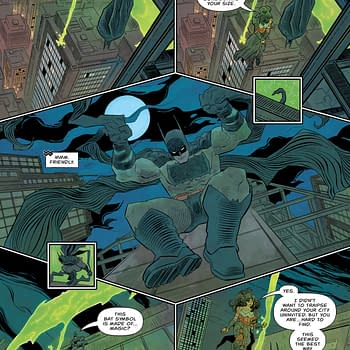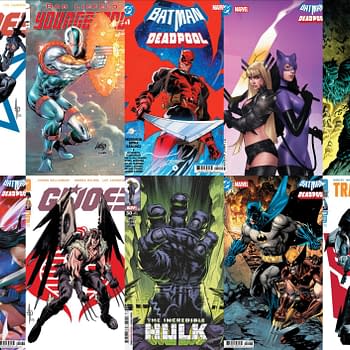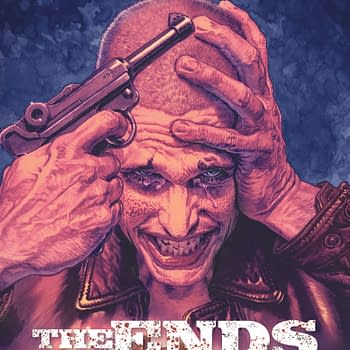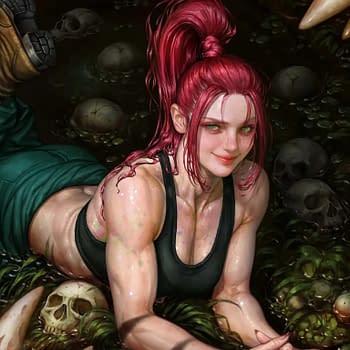Posted in: Comics, Recent Updates | Tagged: batman/superman, boom studios, Comics, dc comics, entertainment, future's end, grant morrison, justice league, multiversity, sirens, teen titans
Thor's Comic Review Column – Multiversity: Society of Superheroes, Sirens #1, Futures End Month: Week 3
This Week's Comics Include:
The Multiversity: Society of Superheroes: Conquerors from the Counter-World
Sirens #1
Futures End Month, Week 3
The Multiversity: Society of Superheroes: Conquerors from the Counter-World #1 ($4.99, DC)
By D.S. Randlett (@dsrandlett)
This is a ridiculous long game.
Everybody remembers Action Comics #9 and the storyline that came after right, with Calvin Ellis ("Superman done right" according to an alternate universe Lois Lane), Superdoom, and the evil fifth dimensional imp, Vndktvx? A lot of people have swept that series of issues under the rug in their Grant Morrison head canon. Granted, there's a lot about it that doesn't work from a sheer story standpoint (And much that does. Issue 13, featuring the return of Krypto, is an all timer), but it really works. Despite the flaws, I found myself really liking these issues and their core thesis: That Superman will endure the meddling attempts of a cynical corporate culture. Morrison's ambitious (but pretty straightforward for him) Multiversity broadens that thesis out a bit, especially in this latest issue, and starts forming the next chapter in the thematic saga that includes (but perhaps is not limited to) Final Crisis and the back half of Morrison's run on Action.
But first, a few words about the surface layer here. If this were just an "Imaginary Story" set in an alternate universe, I would have loved it. The new spins on various DC heroes are all really great. The alternate DCU here is without a Superman, and still mostly still sticks to the pre-Superman pulp heroic types. Grant Morrison and Chris Sprouse's version of Doctor Fate, here "Doc Fate," evokes the obvious Doc Savage archetype (with a surprise added as to his identity, which I won't spoil even though it shouldn't be shocking) while still feeling like Doctor Fate, and, well, very DC Comics in a way that DC Comics itself hasn't felt like in a very long time. Even though the story is narrated by The Immortal Man, the good guy version of Vandal Savage, Fate is easily the standout character here, as he has the best moments and leaves the largest impression. If "Hey Presto!" doesn't become a huge comics Tumblr meme, we are failing as fans. Basically, Doc Fate is awesome, and I hope that we see more of him.
Chris Sprouse's art is as good as ever. He has always excelled at evoking a very specific era and feel. He is arguably most known for his work with Alan Moore on Supreme and Tom Strong, and for good reason. In S.O.S., he leverages all of the same strengths that made his work on those books stand out to deliver a truly beautiful issue that is stunning in its style and clear in its storytelling. In the aforementioned Doc Fate moments? A lot of that is down to Sprouse, who makes these little moments sing. Where a lot of the feeling behind books like Final Crisis or Action got lost amid changing artists, the fact that Sprouse has one issue to worry about brings a clarity of vision that makes the latest issue of Multiversity feel like an honest-to-god story rather than an essay.
But Multiversity still kind of is an essay, just one that manages to strike its balance better than its predecessors so far. So what is it saying?
Back to Action Comics for a bit. There's a scene where and alternate universe Lois Lane describes how her world created Superdoom by basically turning Superman into what the people of that world wanted him to be. The implication in Action was that there was this rival idea as to what Superman was or should be aside from the basic Superman who was this basically decent heroic avatar of America's Progressive age. This sorporatized world wanted him dark and violent, and this version of Superman would go on to consume other versions until he was ultimately defeated by "our" Superman. Morrison's Action was, in the long run, about the core resilience of Siegel and Shuster's original idea. Morrison's run encapsulated a lot of what was going on with the character at the time, the drive to make him something much more like what a corporation can understand and deal with the way that it can with an idea like Batman. At the time I thought that the story was one of Morrison's "hypersigils." And act of fiction designed to protect a character and cultural force that clearly means a lot to Morrison.
Where Action was designed to protect Superman (and it seems to have won, as DC seems to be walking the character back in other titles closer to something that we can recognize), Multiversity seems to be his attempt to protect the DC Universe, and maybe push the very corporate-feeling New 52 into a direction that's more recognizable to actual human beings. The first issue of Multiversity featured a race of beings who called themselves The Gentry. Many have pointed to the scene where Nix Uotan, the last of the Monitors (and analog for comics readers and creators), confronts and is ultimately corrupted by these beings as a simple dig by Morrison at editorial. Given that Morrison has a good relationship with DC editorial, I doubt that that's strictly the case. Rather, The Gentry, who are mentioned by Felix Faust in S.O.S., seem to be standing in for the same homogenizing corporate culture ("We want to make you like us," they say) that Vndktvx and Superdoom represented in Morrison's Action.
In S.O.S., we see that the supervillains of that issue's world have sided with The Gentry. This makes perfect sense. Where Superman, and thus the superhero, emodies the ethos, principals, and the paradoxes of personal liberation, then supervillains represent the opposites of those. They represent control. They represent disconnection. These are things that Morrison seems to think that corporate media culture understands and traffics in, and it's starting to consume everything. In turn, Multiversity seems to be Morrison's attempt to give the genre, particularly in its DC iteration, the weapons it needs to fight back. Morrison and his collaborators seem to be publishing a reminder that, in this era of samey superhero movies, that comics have always and will always do it better. After all when, in the first issue of Multiversity, The Gentry bid Nix Uotan, the Eternal Reader, to choose his weapon against them, he reaches Superman. He reaches for Doc Fate. He reaches for heroes.
He reaches for a comic book.
S.O.S. has plenty in it that thrills and appeals, but it appears that Morrison's longer meta-narrative has finally found its footing, Part of that is down to the creators, other due to the times and the place that the superhero genre finds itself in. But, as if it weren't obvious, The Gentry, those outsiders, must fall. Long live comics.
Editor and teacher by day, comic book enthusiast by night, Bart has a background in journalism and is not afraid to use it. His first loves were movies and comic books, and although he grew up a Marvel Zombie he's been known to read another company or two. Married and with a kid on the way, he sure hopes this whole writing thing makes him independently wealthy someday. Bart can be reached at bishop@mcwoodpub.com.
Sirens #1 (Boom!, $3.99)
By Jeb D.
The output schedule required by monthly comics from the Big 2 has made the artist-writer something of a rare bird in the world of modern corporate comics, so it's nice when an industry legend like George Perez has the chance to step into both roles, in a project about which he's clearly passionate. And while I can't quite share his passion just yet, the ingredients are in place for Sirens to grow into something worthy of Perez' legacy before he's through.
Sirens is another series with a pretty straightforward elevator pitch: mystically-powered female warriors from a variety of times and places are magically-scientifically brought together to face an ultimate threat, but with the hook that they may, or may not, be the same team of Sirens that the time-hopping enemy destroyed once before, and threatens to do again.
Perez is clearly having great fun with this: it's like he's running a role-playing game, introducing characters by bouncing around from era to era, playing with settings, weapons, and characters: we've got Vikings,* dragons, space people, an ancient Chinese warrior, a female Roman gladiator, a young black American woman with a mysterious secret, a pistol-packin' frontier schoolmarm, and more. The structure is familiar: Perez wildly jump-cuts back and forth through time and space, dropping clues that the reader has to trust will to fall into place in future issues. That's a potential problem, though: if the revelations turn out be as formulaic as the setup, I fear that Perez may squander an interesting set of characters.
The book's largest flaw (and it's one we've seen in other artists turned writers) is Perez' evident unwillingness to trust his visuals to tell the story: page after page of exposition is crammed so full of word balloons that characters seem to be ducking to avoid them; on top of that, too many of those balloons are filled with sci-fi gobbledygook that's not particularly interesting or relevant to us at this point in the story—once we get to know the characters, maybe we'll care about things like the "perimeter of Qroog quadrant epsilon," but to hit us with this sort of generic space-opera stuff right out of the box gives the story a musty, stale feeling.
It would be nice to report that Perez compensates for weaknesses in the script by knocking the artwork out of the park, but while this is certainly among the better-looking comics you'll see this week, it's a little mundane by comparison with Perez' best. Again, it might help if Perez slowed the torrent of exposition, and if fewer panels were disappearing into a deluge of word balloons, because the occasional snippets of action are typically effective. I also found the overall look of the book (including the colors from Leonardo Paciarotti) a little muddy, but I'm reviewing a pdf preview copy, so it's possible that the printed version looks better.
Perez does a fair job of physically distinguishing his female protagonists; distinctive faces have never been his strong point, but on the spectrum of, say, Frank Cho to Terry Moore, Perez lands closer to Moore's brisk characterization than Cho's single-face approach (granted, it's Lynda Carter's face, so who can blame him?).
One thing I've always admired about Perez' work is the way he's able to draw attractive fantasy females without toppling over into prurience or sleaze; and when a man who regularly pals with pornstars at FetishCon knows how to keep that in balance, no one else in the industry has any excuse for continuing to insist that the only way to depict a female character is with pneumatic boobs and gratuitous butt-shots.
As I say, I'm hopeful to see Sirens develop the potential inherent in the various characters and settings. It will also help if we get a stronger sense of why Perez made this a team of all-female adventurers: if he did it just because the industry needs more female-focused books, that's all well and good. But given that most of what action we get consists of run of the mill shooting, stabbing, and slashing, I'd like to see the Sirens distinguish themselves in some way from the endless parade of testosterone squads we've seen over the years.
*Interesting side note: recent archaeological finds suggest that Viking raiding parties commonly included female warriors, as well as male.
Jeb D. is a boring old married guy whose comics background includes attending the very first San Diego Comic-Con, being lectured on Doc Savage by Jim Steranko, and fetching an ashtray for Jack Kirby. After a quarter-century in the music biz, he pursues more sedate activities these days, and will certainly have a blog or Facebook account or some such thing one day.
Futures End Month, Week 3 (DC Comics, $2.99/$3.99)
By Graig Kent
Had I far more time on my hands and exponentially more money, I would purchase all of the Futures End one-shots coming out this month, (and since I theoretically would have exponentially more money, I would splurge, paying the extra dollar for the lenticular covers, even though they're not all that great, quite frankly). Why? Because these sort of "what if?" hypothetical stories intrigue me. I bought all of the Armageddon 2001 crossover annuals back in '91 and every one-millionth issue of the DC 1,000,000 crossover back in Grant Morrison's late-'90's JLA days for that very same reason. It's like Doctor Who-ing your way around the DC Universe, getting a glimpse of what might come in the near and/or distant future, with little mind as to the real world changes that might occur in-between. It's escapism from one's escapism. And had I the time, I would reread both those previous crossovers and try and highlight the differences in storytelling and event structure as the decades jump between them. Alas.
These sort of things do present a curious exercise in compressed storytelling and rapid world building. In that sense, the world of Futures End and this month of deviations from the ongoing series is like a whole new reboot, a whole new world of these characters to explore.
Every writer handles them differently.Some like Wil Pfeifer with Teen Titans: Futures End, basically write a pilot issue for a whole new series that's never going to happen. For readers of the Futures End weekly, you know that the Teen Titans of today were all killed (save for Tim Drake) during the Earth War, and so this tie-in will naturally present an entirely new team of Titans, only this time they're comprised mostly of Earth 2 refugees fighting against the "Earthism" in politics and society to try and make things better for themselves and others. I can't say whether we've seen the Earth 2 analogs for Klarion, Aqualad, and Kid Flash to this point but Pfeifer writes them as the plucky young upstarts that a Titans team should be. They're joined by The Heretic (one of the Damian Wayne clones, I presume) and Animal Girl (possibly B'wana Beast's daughter? It's not Maxine from Animal Man), as they take on a hyper-wealthy kid-industrialist. It's oversimplified in its politics and spotty with the details on some of these new characters, but generally it's a brightly colored, light and breezy, if unimportant, read.
Justice League: Futures End [*SPOILERS AHEAD] picks up where last week's Justice League United tie-in left off, with the "5-years-from-now" Justice League on Mars trying to quell a prison break of some of the planet's (and galaxy's) most dangerous villains. The ringleader is Captain Atom, who has manifested very much into his Dr. Manhattan analog, coming to understand the fabric of the universe in a way no mere human can. He's becoming the ultimate power that has ever existed, and yet, he's still having his growth spurt, which means he can't figure out how to escape through Mars' force field, nor how to draw out the knowledge from his opponents. The Captain Atom series that launched with the New 52 was a beautifully rendered but choppily written book such that I only lasted 2 or 3 issues into its brief run. Suffice it to say, I cannot comment on how this story jibes with that series run, or if this Watchmen connection was the path it was headed down. Jeff Lemire drafts an interesting story pitting this rag-tag future Justice League against a near-god like Captain ManhAtom, where they look well beyond outmatched, the only thing missing is the motivation ol' Captain A has for his actions and the outre use of his powers. In the more unfortunate side, Jed Dougherty's illustrations serve the story rather poorly with blocky faces, stiff figure work, awkwardly staged panels, and an overall cheap B-movie feel. The epic scale that this should be working on is definitely missing. If I envision, say, Doug Mahnke drawing this, it get's infinitely better. As a two-parter in the Futures End world, written by one of the weekly's architects, it's surprisingly light on integrating with the main book, and as a result is easy enough to skip.
As I look upon this Futures End Month as a creative whole, I notice how quick the writers and editors are to abandon the core conceit of the series they're shepherding into the 5-years-later realm. Teen Titans ignores all the characters of its current ongoing series, the Justice League book barely deals with the future team at hand in any exploratory sense, and Batman/Superman: Futures End is 92.5% more Batman than Superman. At least with Batman/Superman, the focus is Batman's thoughts about his missing partner, and dealing with one of Superman's key villains (Metallo, who escapes from a Venusian prison…apparently all the planets in the solar system have been converted into penal colonies in the future), plus a visit to the Fortress and some of Supes' supporting players. It's often astonishing to me how pliable Batman is, and how easily he can be made to fit into any situation or scenario. Everything he does can be in character for him simply because he's practically done everything in his long existence. That here he's dealing with a broken back, donning mech armor, warring with Superman villains, visiting the Fortress, and writing in a journal are all things he's done before, so it's no stretch.
Writer Greg Pak has been toying with the strained early relationship of the New 52's Batman and Superman for a year now, and so there's a fitting note of discord to it still many years on. Cliff Richards illustrates the first half and Jack Herbert with Vincente Cifuentes take the second half, and despite the fact that Richards is more Jae Lee-esque while Herbert and Cifuentes are more Gene Ha, it's not a jarring transition between the two and overall it's a great-looking book. It's not important but it's a solid read.
Next week: Harley Quinn, Superman, and Booster Gold
Graig Kent is currently attending a 10-day stand-up comedy festival in Toronto. It's still comics, but of a different sort. He is on twitter @thee_geekent and his dog has a blog tacomblur.tumblr.com




















